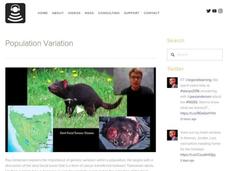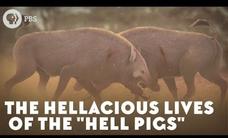FuseSchool
Variation
CREDITS Animation & Design: Waldi Apollis Narration: Dale Bennett Script: Lucy Billings Look at these baby animals. You will have immediately observed how cute and fluffy they are but you will also have noticed that they are different -...
Professor Dave Explains
The Evolution of Populations: Natural Selection, Genetic Drift, and Gene Flow
After going through Darwin's work, it's time to get up to speed on our current models of evolution. Much of what Darwin didn't know is now known and understood very well, so we can meticulously go through much of the evidence we see for...
Wonderscape
Science Kids: Biology Terms
In this video, students will learn about important terms in biology, including the definitions of living and non-living, life cycles, endangered species, and extinct species. The video breaks down these concepts and provides examples to...
Visual Learning Systems
Prokaryotes: Characteristics of Prokaryotes
Bacteria are the most abundant living things on the planet. In fact there are more bacteria in your mouth than there are vertebrates on the planet. This fascinating series of videos explores the wide-ranging forms and characteristics of...
FuseSchool
What Is Asexual Reproduction
Asexual reproduction only needs one parent; all the offspring are clones. This means they are genetically identical to one another and to the parent. Many plants use asexual reproduction, like spider plants. Bacteria also reproduce...
FuseSchool
Mutations
So, what causes mutations? Well, this is where science fiction meets science fact, sort of. In the backstory of many superheroes there will be a meeting with a radioactive substance - be it cosmic rays or radioactive waste. In real life,...
Be Smart
The 12 Days of Evolution - Complete Series!
Scientists believe red hair and pale skin evolved in northern Europe because it helped humans synthesize vitamin D easier than those with more melanin in their skin. Viewers explore many interesting facets of evolution in a...
SciShow
Great Minds: Gregor Mendel
How would you feel if you made a huge scientific discovery, published it everywhere, and shared it with every scientist, only to have it ignored for 35 years because no one understood your genius? Unfortunately, Gregor Mendel died before...
Bozeman Science
Population Variation
Tasmanian devils are scavengers who eat dead animals including the bones and fur. A video begins with cancer in Tasmanian devils to demonstrate the importance of genetic variation. Then examples such as the black-footed ferret and AIDS...
Crash Course
Natural Selection
The peppered moth is featured in a video about natural selection. The narrator tells the story of Darwin's theory and then moves on to the principles behind natural selection and the different ways it works. Concepts covered include...
Bozeman Science
Cellular Variation
Variety truly is the spice of life. A video explores how plants have both chlorophyll a and b and the benefits of possessing both, how varying molecules allows for winter wheat, how possessing the heterozygous combination of sickle-cell...
PBS
What Is Race?
Geneticist David Altshuler discusses the results of his 1000 Genome Project and his research that shows that people across the world share 90% of the same DNA, that race, as it is thought of today, is a 19th century social historical...
PBS
The Hellacious Lives of the "Hell Pigs"
Some animals have more in common than meets the eye. An episode of the PBS Eon series analyzes the fossil records of a mammal nicknamed the hell pig. The lesson describes how evolutionary methods determine the genetic evolution of the...
Bite Sci-zed
Mitochondrial DNA
Do young scientists know that some traits are only passed down by the mother? Mitochondrial DNA is an interesting phenomenon that provides researchers with a lot of useful information. Scholars learn about the endosymbiotic theory, what...
PBS
How Blood Evolved (Many Times)
Red, purple, green, blue, and white are all colors of ... animal blood! Young scholars learn about the evolution of animal blood over time in a video lesson from a comprehensive Eons series. They learn that not only has the color...
PBS
When Humans Were Prey
A quarry worker in southern Africa discovered the first fossil evidence that the human species originated on the continent less than 100 years ago! Evidence from the specimen indicates the first humans were not the hunters—but the prey....
PBS
When Apes Conquered Europe
Where are they now? Apes are humans' closest evolutionary ancestor, yet they only live in small areas in Africa and Asia. Learn how their geography changes with evolution in a video lesson from the PBS Eon series.
PBS
Your Place in the Primate Family Tree
Your family get-togethers are about to become more interesting! A video lesson in the PBS Eons series describes the primate family tree that leads to the one and only—homo sapiens. Discover the fossil evidence that leads scientists to...
Nature League
What is Reproduction? - Lesson Plan
What force drives a species' will to survive and thrive? Explore reproduction through the first of a four-part video series. The narrator discusses both sexual and asexual reproduction and cites examples of each.
Amoeba Sisters
Genetic Drift
Survival is a game of chance, catch my drift? Examine the factors that influence genetic drift with an entertaining video from a large biology playlist. The resource covers the myriad conditions that come into play when a species...
FuseSchool
Selective Breeding
Did you know that selective breeding is behind the food we're eating? Discover the agricultural practice that changed humans from foragers to farmers using an insightful video that is part of the Fuse School playlist on Evolution. Young...
Bozeman Science
LS3B - Variation of Traits
Make sure your unit on trait variation causes a sensation! Take an in-depth look at standard LS3B, an important component of the Next Generation Science Standards. The narrator discusses methods of delivering the standard to younger...
Bozeman Science
LS4D - Biodiversity and Humans
Humans have both positive and negative impacts on biodiversity. A video lesson highlights important human impacts on biodiversity through examples and diagrams. The narrator provides insight to the progression of the topic from...
Teacher's Pet
Population Genetics
Population genetics deals with genetic differences within and between populations. The video explains why this is the lowest level of evolution. Then it discusses mutations, environmental factors, genetic recombination, and random gamete...


















